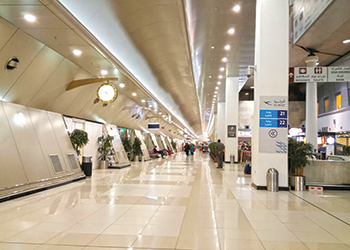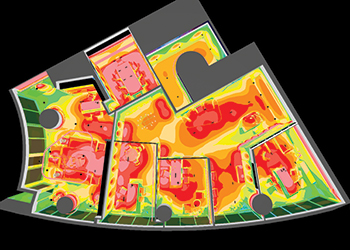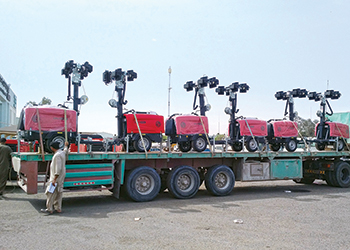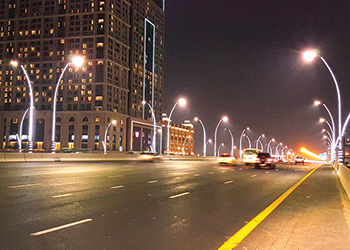
 False colour rendering ... showing the light levels achieved with specified fixtures.
False colour rendering ... showing the light levels achieved with specified fixtures.
While lighting designers aim for great results, projects do not end up as envisioned. REGINA SANTOS, associate lighting designer at Godwin Austen Johnson (GAJ)*, highlights some of the pitfalls.
All projects – whether large-scale venues for events such as the 2020 World Expo in Dubai and the Fifa World Cup 2022 in Qatar or smaller retail and hospitality ones – start as concepts with well-crafted 3D renderings showing stunning architecture and interior design.
The input of the lighting designer in a project can be from the early stages or once the renderings are finalised. His input is essentially throughout the design phase, where he presents the lighting concept as portrayed in the renderings, follows up with the proper specifications in schedules and lighting layouts, and takes responsibility for the lighting design during all design stages.
Before presenting a design, every single fixture specified in a luminaire schedule is tested because different LED fixtures from different manufacturers will behave differently. Details such as how the light behaves, output and beam, light spread, uniformity of the beam and the edges of the projected light are looked into.
One also needs to bear in mind the lighting application – whether an artwork or an office space that is being lit, or if the light is highlighting a vertical surface or a horizontal plane.
Other aspects to consider include light intensity and the fall-off area; and the lighting power density for individual spaces as well as for the whole building to give a more accurate power wattage for better energy efficiency.
Risks
However, by the time the lighting designer wraps up his job, the quantity surveyor (QS) has already made budget assumptions based on low-cost fixtures used at other projects he has worked on but which may not necessarily relate to the project in hand. Often these fixtures are not suitable due to a number of reasons (lumen output, optics, colour temperature, colour rendition, maintainability, visual appearance etc), especially with regard to LED fixtures.
It, therefore, is imperative that the QS is fully briefed on all project specifications. This will enable him to truly assess the real costs, following the quality parameters first proposed during fixture selection and presented to the client – including the quantities and accessories. This information, however, is usually often available after the QS has made his initial assessments.
Also essential for all stakeholders is building a relationship based on trust with the client, to create the best project possible. He needs to be briefed on the different light fixtures being specified for his project and why these have been chosen. This helps him understand how serious the selection process is, and that it is all for the benefit of the project.
Another challenge for a lighting designer is value engineering exercises, which today tends to be focused on saving costs. This often results in a project that, in terms of quality, ends up in sharp contrast to what had originally been envisioned.
What is not understood during the proposal of alternatives for cost exercises is that the fixtures have been selected after careful assessing them for criteria such as performance, efficacy/efficiency, lumen output, visual appearance, maintainability, fit-for-purpose and suitability for the region’s harsh environment.
So if the QS or contractor recommends a budget which is a fraction of the cost of the light fixtures, we have to question what it is based on.
They are not lighting experts and more often than not will make assumptions based on cost and neglect the ‘value’ aspect of the term ‘value engineering’, which should try to retain quality.
Finally, if two fixtures claim to perform the same, a lighting designer would recommend the least expensive fixture after testing and comparing their working samples, because he works for the benefit of the client.
• GAJ is one of the longest-established UK multi-disciplinary architectural, interior design, specialist lighting and MEP practice in the UAE. It has particular expertise in hotel and hospitality, residential and commercial, education, sport and leisure design. Throughout its 25-year history, the company has created some iconic buildings in the Emirates in addition to a wide range of built and ongoing projects across the Middle East and North Africa.





















_0001.jpg)


.jpg)
















.jpg)








.jpg)




